Understanding Morgue Doors: Function, Design & Selection
Morgue doors are specialized entryways designed for mortuary coolers that maintain deceased bodies at temperatures between 36°F and 39°F. These doors serve as critical components in funeral homes, hospitals, and medical examiner facilities.
| Key Aspects of Morgue Doors | Description |
|---|---|
| Primary Function | Temperature maintenance, security, and dignified access |
| Common Materials | Stainless steel, galvanized steel, and fiberglass reinforced plastic (FRP) |
| Standard Features | Heavy-duty gaskets, cam-lift hinges, and positive-seal latching systems |
| Temperature Range | Designed to maintain interior temperatures of 36°F-39°F |
| Security Elements | Keyed locks, electronic access controls, and alarm integration |
Morgue doors differ significantly from standard doors in both construction and purpose. They're engineered with specialized sealing systems to maintain precise temperature control while providing easy access for mortuary cots and body lifts.
The design balances several critical factors: * Thermal efficiency - preventing temperature fluctuations * Hygiene standards - allowing for thorough cleaning and disinfection * Security requirements - controlling access to sensitive areas * Operational functionality - supporting smooth workflow in limited spaces
When selecting morgue doors, funeral directors must consider facility size, body capacity needs, and local climate conditions, as these factors significantly impact both performance and energy costs.
I'm Mortuary Cooler, a national-level supplier of mortuary coolers and specialized morgue doors with extensive experience helping funeral homes select the right morgue doors for their specific facility requirements.
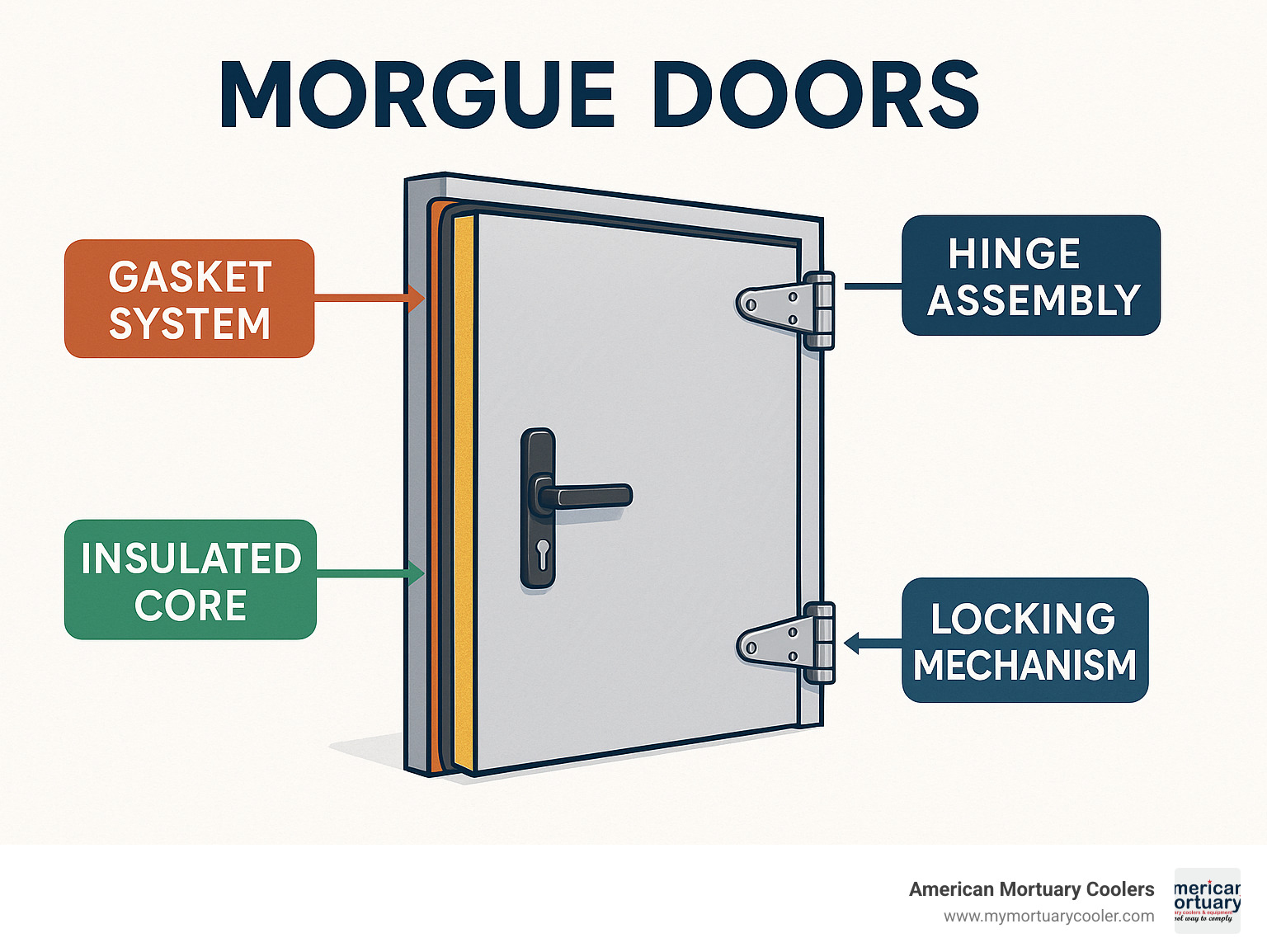
Morgue Doors 101: Definition, Types & Workflow Impact
When we talk about morgue doors, we're discussing much more than just an entryway. These specialized doors are the guardians of dignity, the keepers of temperature, and the facilitators of compassionate care in the mortuary setting.
At American Mortuary Coolers, we've spent years helping funeral homes select the perfect morgue doors for their unique needs. The right door makes all the difference—not just in preserving the deceased, but in creating a workflow that honors both the departed and those who care for them.
What Is a Morgue Door?
A morgue door serves as the primary barrier between the controlled environment inside a cooler and the outside world. These aren't standard household doors—they're precision-engineered systems designed to maintain that critical 36°F to 39°F temperature range essential for proper preservation.
A quality morgue door does three key jobs: it creates a reliable temperature seal, provides necessary security, and ensures dignity through its design and operation.
Unlike conventional doors, these specialized entryways withstand frequent sanitization with hospital-grade disinfectants while operating flawlessly in high-humidity conditions. They're built with thicker insulation, heavier-duty hardware, and specialized gaskets that create an airtight seal.
You'll find different styles serving various needs in the mortuary setting. Some facilities need compact body box doors for individual storage units, while others require larger walk-in cooler doors that allow staff comfortable access to the entire cooling chamber.
Where Morgue Doors Fit in the Mortuary Workflow
The journey of caring for the deceased follows a careful, respectful path—and morgue doors stand at critical transition points throughout this process.
When a body first arrives, staff members transport it through the morgue door into the cooling unit—marking the beginning of the preservation process. During storage, these doors maintain the integrity of the environment, keeping temperatures stable while securing the area from unauthorized access.
Throughout preparation, mortuary professionals pass through these doors numerous times—retrieving bodies for embalming, returning them for storage, and eventually transferring them for viewing or services.
"I've seen how the right morgue door can transform a facility's efficiency," shares one of our customers. "When our staff doesn't have to struggle with sticky doors or worry about temperature loss, they can focus on what really matters—treating each person in our care with respect."
Modern facilities often integrate morgue doors with body lift systems, which help reduce physical strain on staff when moving deceased individuals.
For those looking to optimize their entire mortuary operation, we recommend checking out our comprehensive guide on Comprehensive Solutions for Mortuary Needs: Morgue Coolers, Refrigeration Doors, and Essential Equipment.
Anatomy of Performance: Materials, Insulation, Hygiene & Energy Efficiency
When it comes to morgue doors, what's inside matters just as much as what you see on the surface. These specialized doors aren't just barriers—they're sophisticated systems designed to preserve dignity, maintain critical temperatures, and stand up to years of demanding use.
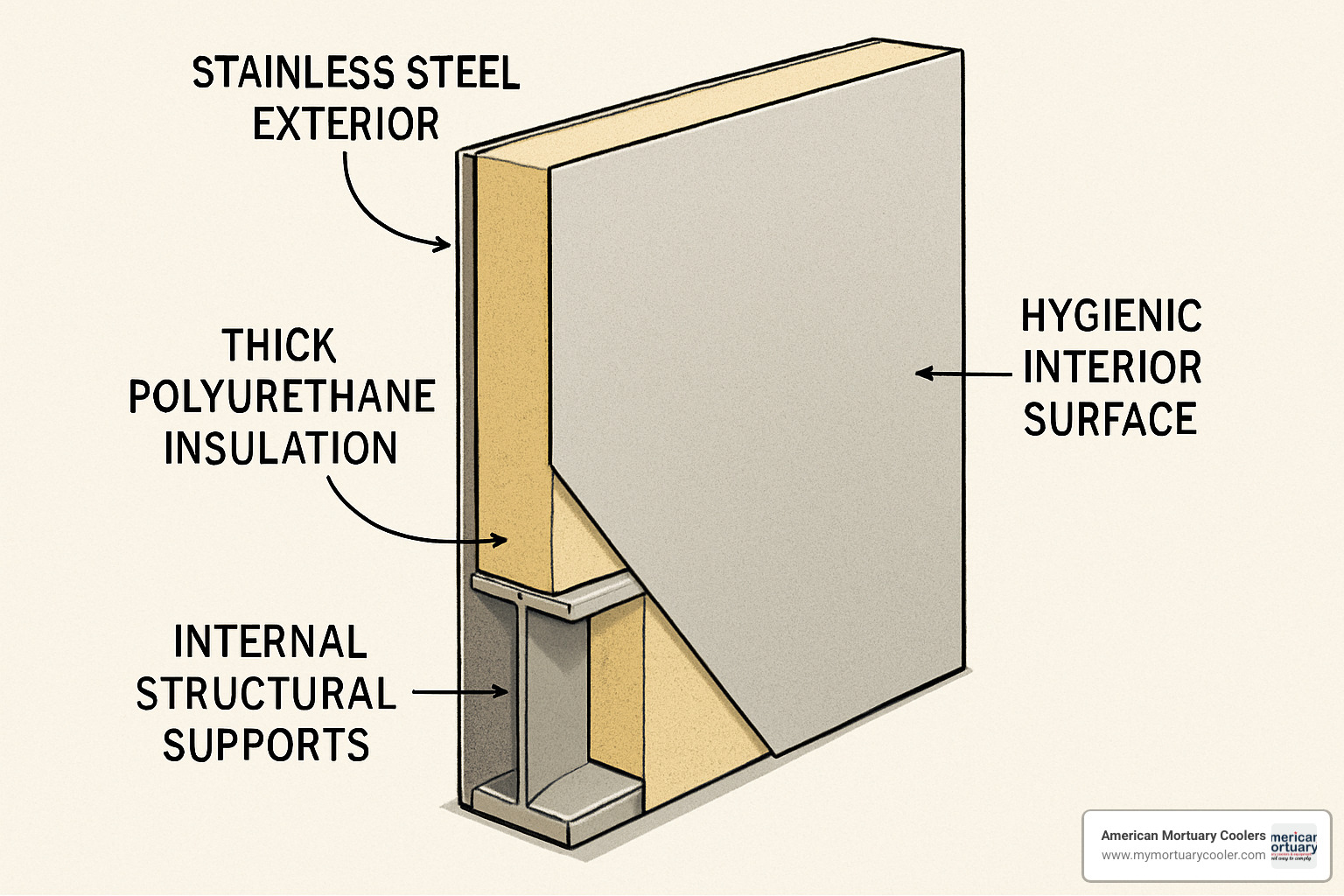
At American Mortuary Coolers, we've installed hundreds of these specialized doors across the country, from small-town funeral homes to busy county facilities. The magic happens in the details—the materials, insulation quality, and design features that create a perfect balance of function and efficiency.
Material Showdown – Pros & Cons
Stainless steel remains the champion in most settings. It offers exceptional resistance to corrosion, stands up to harsh cleaning chemicals, and maintains its professional appearance year after year. The downside? It's heavier and more expensive.
Galvanized steel is the practical middle-ground option. It offers good corrosion resistance at a friendlier price point, handling the job admirably in many facilities where budget considerations come into play.
Fiberglass Reinforced Plastic (FRP) brings something different to the table. Lightweight and available in various colors, FRP won't dent like metal options. The trade-off is that it can scratch more easily and may yellow over time if exposed to UV light.
Aluminum components often find their way into morgue door frames and trim. Naturally resistant to corrosion and lightweight, aluminum makes for excellent supporting elements, though it lacks the impact resistance for primary door material.
The heart of every morgue door is its insulated core—typically foam-injected between exterior and interior facings, creating both a thermal barrier and structural integrity.
Thermal Integrity & Energy Costs
Maintaining that critical 36-39°F temperature range isn't just about respect for the deceased—it's also about controlling operating costs.
The effectiveness of morgue door insulation is measured in R-value, with higher numbers indicating better thermal resistance. Most quality doors feature 3-4 inches of polyurethane foam insulation, creating a substantial barrier against outside temperatures.
The connection points matter tremendously too. Quality morgue doors use cam-lock or tongue-and-groove panel connections that eliminate thermal bridges—those pathways where heat can transfer through.
Climate considerations play a significant role in door selection. Facilities in Miami face different challenges than those in Minneapolis. That's why we tailor insulation specifications to match local conditions.
The specialized gasket systems on morgue doors create an airtight perimeter that prevents both temperature exchange and unwanted condensation—a critical factor in maintaining proper conditions.
For those looking to dive deeper into cooling efficiency for mortuary applications, our guide on The Complete Guide to Walk-In Mortuary Refrigerator Specifications offers valuable insights for facility planning and upgrades.
Security & Control: Locking Systems, Seals, Smart Integration
When it comes to handling human remains with dignity and respect, security isn't just a feature—it's an absolute necessity. Morgue doors need robust security systems that protect the deceased while giving authorized staff efficient access.
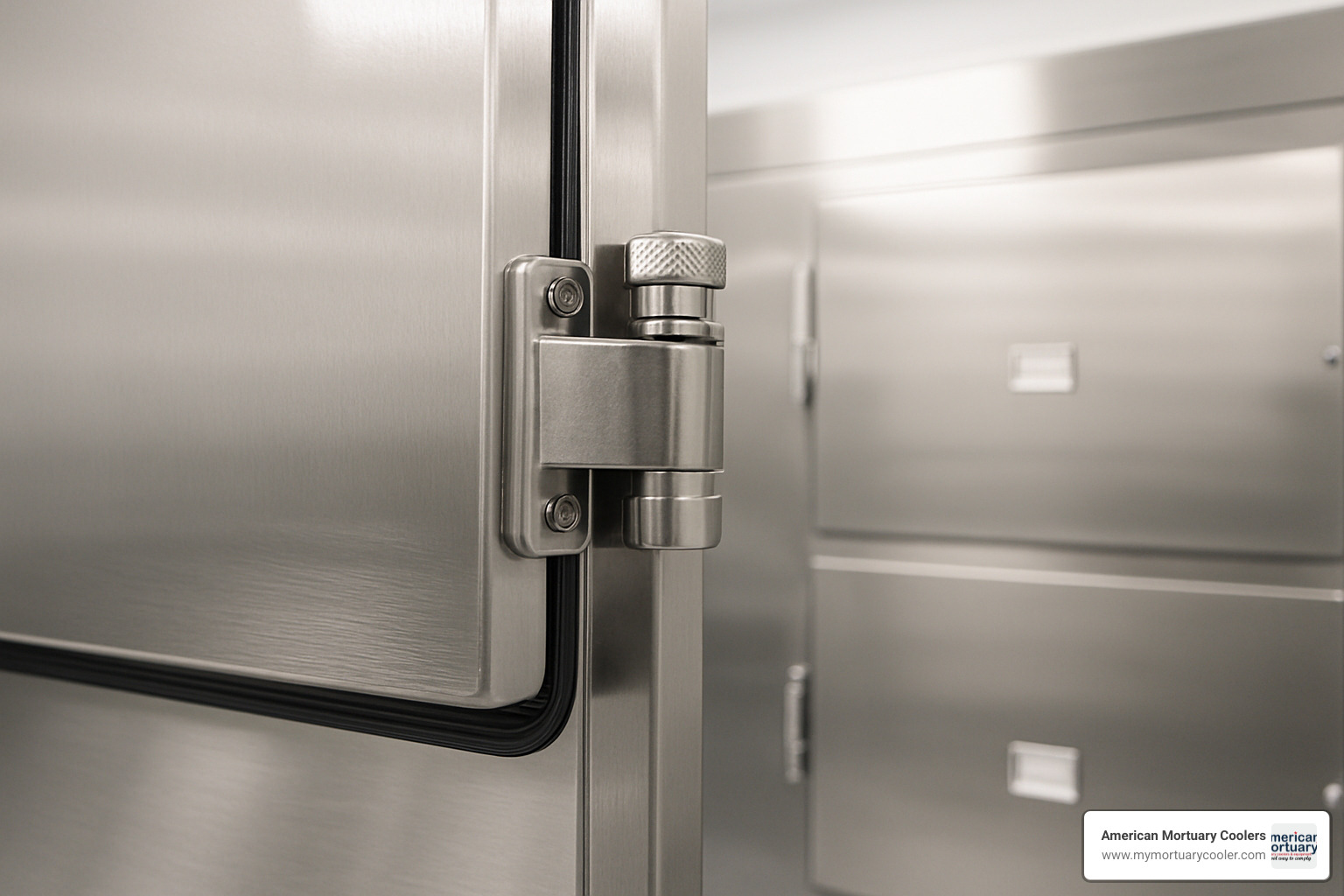
Today's morgue doors come equipped with various security features that work together. Compression latches create essential pressure on gaskets for an airtight seal. For basic security, traditional keyed locks still have their place. More advanced options include magnetic locks that integrate with broader facility security systems.
We've installed countless automatic door closers that prevent those "oops" moments when someone forgets to fully close the door. These work alongside alarm contacts that alert staff when doors are left open too long or accessed at unusual hours.
"In recent years, we've seen a real shift in what our customers want," says our security specialist. "Clients in bigger cities are increasingly asking for RFID systems that track exactly who accessed the morgue and when—creating a detailed digital paper trail for security and compliance."
Sealing the Deal—How Morgue Door Gaskets Work
The unsung heroes of any morgue door are definitely the gaskets. These rubber or vinyl components might not look impressive, but they're critical for maintaining that precise 36-39°F temperature range.
The most common type are compression gaskets that squish down when the door closes, creating that essential airtight seal. Magnetic gaskets use magnetism to maintain constant contact with the door frame. Sweep gaskets prevent air from sneaking under the door, while wiper gaskets provide additional sealing.
"I always tell our customers to give their gaskets a good once-over every three months," shares our maintenance team leader. "And plan on replacing them every year or two depending on use. A worn-out gasket can spike your energy bill by up to 30% and potentially compromise the preservation environment."
For a deeper dive into gasket care, check out our detailed guide: The Ultimate Guide to Walk-In Freezer Door Gaskets Replacement.
Smart Morgue Doors & Access Analytics
The digital revolution hasn't bypassed the funeral industry. Today's morgue doors can be surprisingly high-tech, offering features that would have seemed like science fiction just a decade ago.
Modern smart door systems feature badge readers that limit access to staff with proper credentials. These systems create detailed audit trails that log every entry and exit. Temperature alarms immediately notify managers when door openings cause concerning temperature fluctuations.
For facility directors, remote monitoring capabilities allow them to keep tabs on morgue access from their phone or computer. Many systems also offer automated compliance logging that simplifies documentation for regulatory requirements.
From Spec to Service: Installation, Maintenance & Regulatory Compliance
Getting morgue doors right isn't just about choosing quality materials—it's about proper installation and ongoing care. Whether you're updating an existing facility or building from scratch, how your doors are installed and maintained directly affects their performance and longevity.
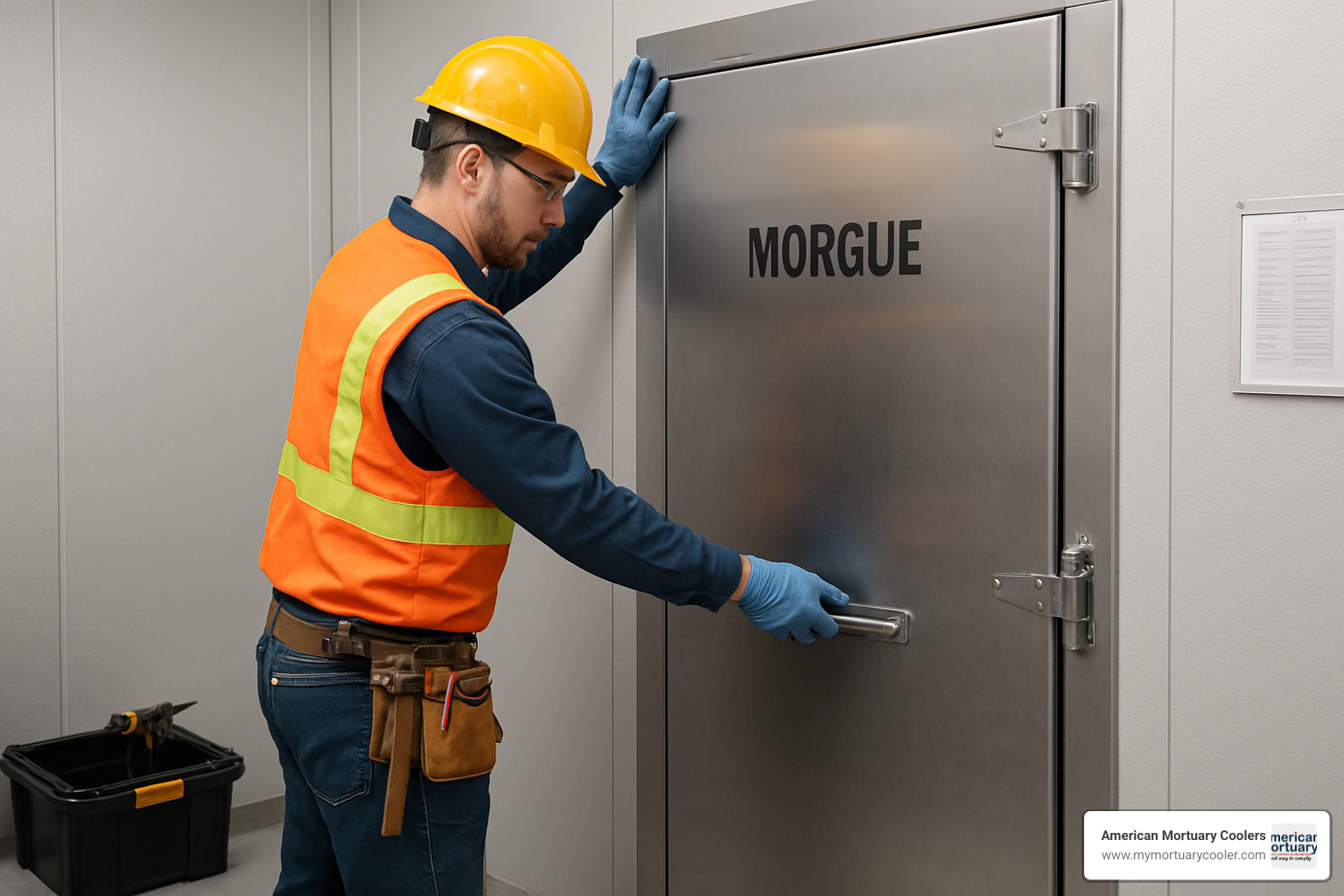
Installing Morgue Doors in Existing Coolers
Retrofitting isn't as simple as swapping out the old for the new. It's a bit like tailoring a custom suit—precision matters.
"I remember a project in Tennessee where the building had settled over 40 years, making nothing quite square," shares Mike, our head installer. "We had to custom fabricate on-site to make everything fit perfectly."
When retrofitting morgue doors, we start with careful field measurements of the existing opening. We measure multiple points because older buildings rarely have perfectly square openings.
Next comes choosing between overlap installation (where the door mounts on the face of the opening) or flush installation (where it sits inside the opening). Each has its place depending on your facility's needs.
Hinge alignment is particularly crucial for morgue doors because they're heavier than standard doors due to their insulation. Proper alignment prevents sagging and ensures smooth operation when staff are moving gurneys or body lifts.
For facilities considering a door replacement, our Definitive Guide to Walk-In Cooler Doors walks you through the entire process in detail.
Maintenance Checklist for Long-Term Integrity
Think of your morgue door maintenance like regular oil changes for your car—skip them at your peril.
Monthly attention should include inspecting gaskets for cracks or compression loss. These rubber seals are the frontline defense against temperature fluctuations. Wipe them down with mild disinfectant—harsh chemicals can degrade the rubber prematurely.
Quarterly maintenance should focus on the moving parts. A little lubricant on hinges prevents metal-on-metal wear that can eventually affect door alignment. This is also the perfect time to check that your door closer is properly adjusted.
With proper care, a quality morgue door should give you 15-20 years of reliable service—a significant return on your investment.
Meeting the Rules—Safety & Regulatory Standards
Navigating the regulatory landscape for morgue doors can feel overwhelming, but it's essential for protecting everyone involved.
Morgue doors must satisfy requirements from multiple authorities. OSHA focuses on worker safety, including emergency egress and proper signage. The CDC provides guidelines on infection control that influence the cleanability of surfaces and seals. Local health departments often have specific requirements about the handling and storage of human remains.
Fire safety is another crucial consideration. NFPA 101 (Life Safety Code) may require fire-rated construction for morgue doors in certain building configurations.
Privacy concerns extend beyond the living. HIPAA protections often apply to the deceased, meaning your morgue door design should consider visibility issues. Many facilities opt for doors without windows, or with small, frosted viewing panels that maintain dignity.
Time Capsules: Historical Variations & Emerging Innovations
The story of morgue doors is a fascinating journey through time, reflecting our evolving relationship with death, architectural innovation, and technological advancement. From simple wooden structures to today's high-tech solutions, these specialized entryways reveal much about how we've cared for the deceased throughout American history.
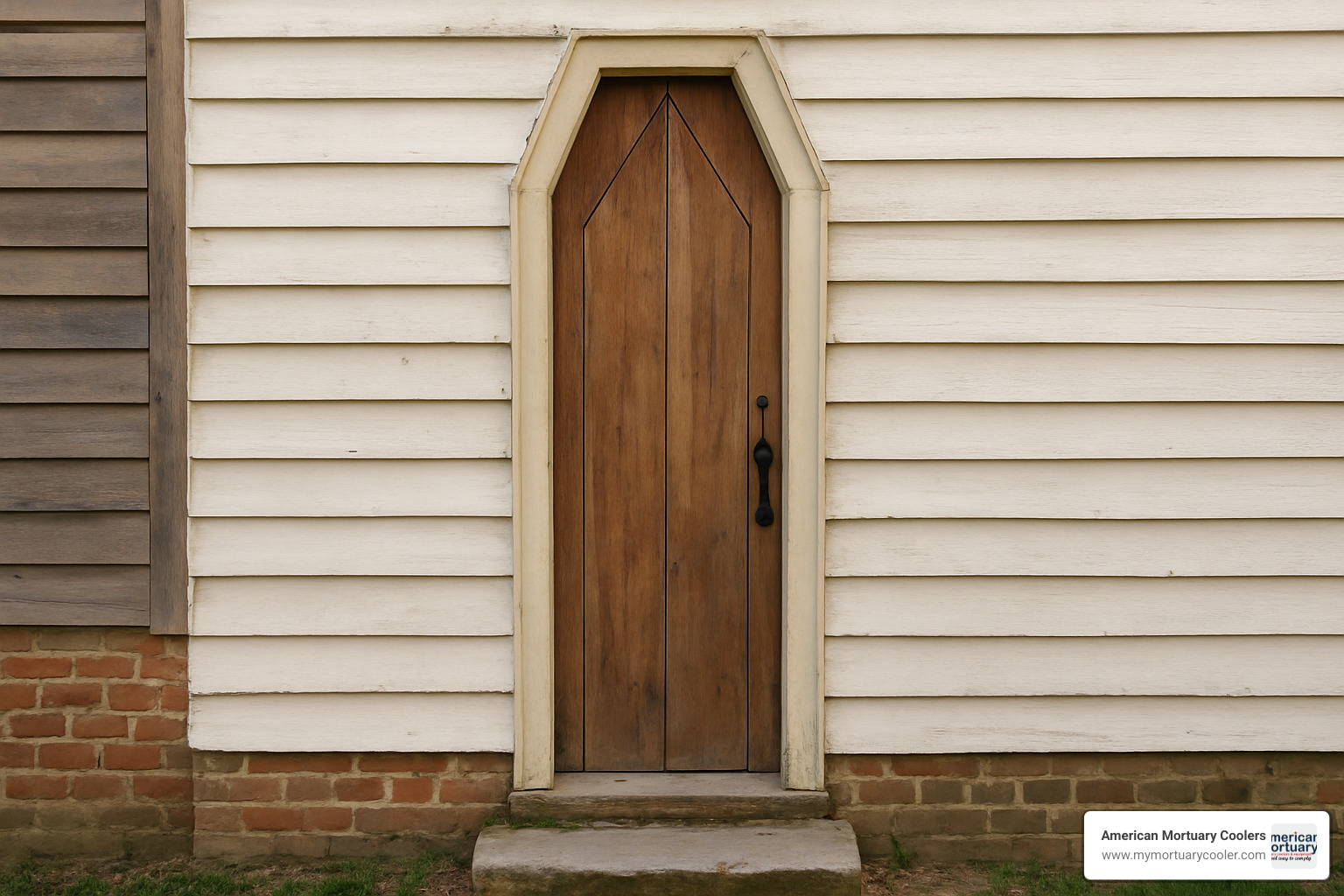
From Coffin Doors to Modern Morgue Doors
Long before refrigeration, our ancestors created specialized doorways to address the practical challenges of death. In colonial America, many homes featured "coffin doors" or "funeral doors" – narrow entryways specifically designed for a solemn purpose.
These early predecessors to modern morgue doors typically sat adjacent to the front parlor, which often doubled as a viewing room during times of loss. They were narrower than standard doors but tall enough to accommodate a coffin carried vertically – a practical solution in homes with central chimneys or tight staircases.
Interestingly, the common phrase "death's door" likely originated from these specialized entryways, a linguistic remnant that persists in our everyday speech. You can learn more about these historical doorways at sites like Coffin Door.
The Victorian era brought significant innovations that would eventually influence morgue door design. As funeral practices shifted from home viewings to funeral parlors, and refrigeration technology emerged, the modern concept of the morgue door began to take shape.
What's Next for Morgue Doors?
At American Mortuary Coolers, we're excited about the future of morgue door technology. The innovations on our horizon promise to make these essential components more efficient, hygienic, and environmentally responsible.

Some of the most promising advancements include antimicrobial surfaces infused with silver ions that actively reduce contamination risks. Touchless access systems using motion sensors or voice commands eliminate the need to physically contact door handles, further enhancing hygiene protocols.
The insulation technology is advancing rapidly too. Vacuum-insulated panels (VIPs) provide remarkably high R-values in much thinner profiles, allowing for sleeker door designs without sacrificing thermal efficiency.
Energy efficiency is another frontier we're exploring. Solar-powered sensors can monitor temperature and door status independently of facility power, providing backup security during outages. Meanwhile, 3D-printed custom gaskets allow for on-demand manufacturing of perfectly fitted replacement parts.
Perhaps most exciting is the integration of smart technology. These connected systems provide real-time monitoring of door operation, temperature stability, and access patterns – helping facilities identify potential issues before they become problems.
With our nationwide presence – from Johnson City, Tennessee to Los Angeles, California – we're uniquely positioned to understand how regional factors influence morgue door requirements. The future of these specialized entryways isn't just about better materials or smarter technology – it's about creating solutions that honor the deceased with dignity while supporting the dedicated professionals who care for them.
Frequently Asked Questions about Morgue Doors
How do morgue doors differ from standard refrigeration doors?
When you first glance at a morgue door, you might think it looks similar to the door on a restaurant's walk-in cooler. Look closer, though, and you'll find thoughtful differences that make all the difference in a mortuary setting.
Morgue doors are built with specialized gasket systems that maintain that critical 36-39°F temperature range needed for proper care of the deceased. Unlike their commercial cousins, these doors incorporate more robust security features—after all, dignity and respect demand controlled access to these sensitive areas.
The materials used in morgue doors tell another part of the story. Their non-porous surfaces stand up to frequent cleaning with hospital-grade disinfectants, an absolute necessity in environments where sanitation is non-negotiable.
Morgue doors are specifically dimensioned to accommodate mortuary cots and body lifts, making the difficult work of mortuary professionals just a little easier.
There's also the matter of appearance. While commercial refrigeration often features large viewing windows, morgue doors typically offer limited visibility or none at all, preserving the privacy and dignity of those in our care.
What locking mechanisms are most common in morgue doors?
Most facilities choose compression cam latches as their primary security measure. These sturdy mechanisms create the mechanical pressure needed for a proper seal while requiring a key for operation—simple, reliable, and effective for many funeral homes.
For facilities in urban areas or those handling forensic cases, electromechanical locks offer improved security by combining traditional mechanical components with electronic controls. These systems integrate seamlessly with building security, giving administrators precise control over who enters sensitive areas.
These modern electronic systems create detailed records of all access events, providing accountability that both protects the facility and ensures proper protocols are followed.
Some facilities, particularly newer hospital morgues, prefer magnetic locks connected to keycard systems already used throughout their buildings. This approach streamlines access management and reduces the number of keys staff members need to carry.
How often should gaskets be replaced on morgue doors?
The humble gasket might not seem like the most exciting part of a morgue door, but this unsung hero deserves your attention. The rubber seals around your door are what stand between proper preservation and temperature fluctuations that compromise your work.
We recommend a quarterly inspection of all gaskets. Take a few minutes to look for warning signs like cracking, hardening, or compression set—that's when the rubber stops bouncing back to its original shape after being compressed.
Under typical conditions, plan to replace your gaskets every 1-2 years. This schedule helps prevent problems before they start and keeps your cooler running efficiently. If your facility experiences high humidity or your door sees constant use throughout the day, you might need to replace them more frequently.
Conclusion
When it comes to protecting the dignity of the deceased and maintaining proper preservation conditions, morgue doors truly stand at the intersection of thoughtful engineering and compassionate care. These aren't just doors—they're specialized barriers designed with purpose and precision.
Throughout my years working with funeral homes across America, I've seen how the right morgue door can transform a facility's operations. A well-designed door doesn't just maintain temperature; it creates a seamless workflow, improves security, and provides peace of mind for the professionals who care for the deceased.
Here at American Mortuary Coolers, we believe in creating solutions that last. Our Tennessee craftsmen take pride in building morgue doors that stand the test of time—because we understand that reliability isn't optional in your profession. Whether you're running a small family funeral home in rural Georgia or managing a large medical examiner's facility in Chicago, your needs deserve custom attention.
What makes me particularly proud of our work is seeing how our doors serve communities across all 48 contiguous states. From the humid conditions of Florida to the dry heat of Arizona, we've engineered morgue doors that perform beautifully in every climate zone.
The mortuary profession is evolving, and so are we. We're constantly incorporating new technologies into our morgue door designs while never losing sight of the fundamentals: durability, efficiency, and above all, respect for the sacred work you do.
For those looking to explore our complete range of mortuary solutions, including customized morgue doors built to your exact specifications, I encourage you to review our A Practical Guide to www.arcticmortuarycoolers.com Mortuary Coolers.
In this industry, I've learned that the smallest details often matter most. A perfectly sealed gasket, a smoothly operating hinge, a lock that never fails—these aren't just product features, they're promises we make to you and to the families you serve. Because at American Mortuary Coolers, we understand that what we're really building isn't just equipment—it's trust.


















